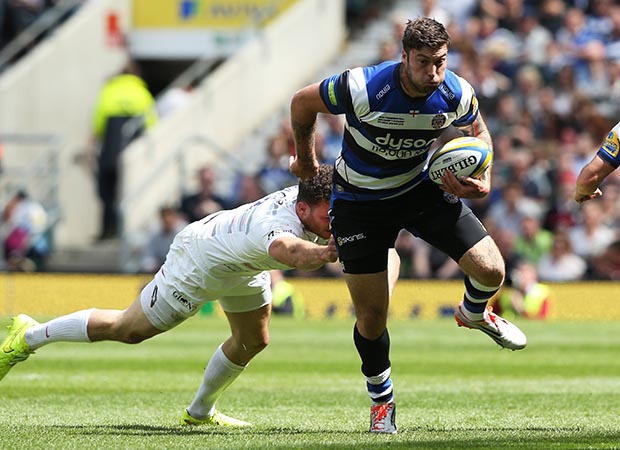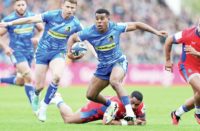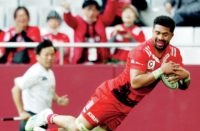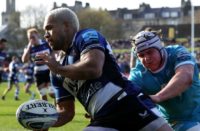 Wingers are try-scorers first and foremost, as they always have been, but in the modern Test arena they've had to develop a much more rounded game. The demands on wings have become greater, because now there is a requirement for them to be good tactical kickers, and also good in the air, whether defending kicks or attacking them.
Wingers are try-scorers first and foremost, as they always have been, but in the modern Test arena they've had to develop a much more rounded game. The demands on wings have become greater, because now there is a requirement for them to be good tactical kickers, and also good in the air, whether defending kicks or attacking them.
They are also seen much more as an extra carrier in the battle to break down defences. Very often the back row and second row are the initial two waves of attack, and then in the third wave the winger comes off the scrum-half in an attempt to make a big dent that fractures the defensive line.
In many ways wings dictate how a side plays, and where it attacks. For instance, last season if Wasps attacked by using Christian Wade or Tom Varndell as carriers or dummy-runners through the middle you knew what was coming. Neither are heavyweights, and consequently most teams would depend on their midfield defence to take care of them one-on-one.
However, if Julian Savea or George North are coming at you, or a Joe Roff or John Kirwan in my era, it's clear as daylight that they are looking to smash you to create space for the next wave. Wingers of that size usually attract a couple of defenders at a time because that's what it takes to stop them, and, as a result, the defensive line will automatically contract as it braces for a big impact. If the ball is then recycled quickly there is usually space on the outside.
At international level wings are so much more involved in the game than in the past, although there were always exceptions. David Campese was the first to adopt a roving role, and because of his remarkable skillset he could play very effectively anywhere from 10 to 15. If Campo popped up at fly-half it was very little different to Michael Lynagh being there. That's what brilliant players can do.
The beauty of wings is that they still reflect a game for all shapes and sizes. When I played there were giants like Jonah Lomu and Inga Tuigamala. Lomu was not just enormous, he was also as quick as Bryan Habana. These days, with the likes of North, Savea and Matt Banahan around, big wingers are not so much of a shock, but thankfully there is still plenty of room for smaller players to make their mark. Wings like Wade, Anthony Watson, and the USA Sevens sprinter, Carlin Isles, may not be super-sized – but they are super-quick.
While wings perform multiple roles their main job is still to finish. That's what they are paid for, and if an international wing makes a mistake by not taking a try-scoring opportunity it is glaring. There is even more intensity now because defences are more organised and chances fewer – so there is big pressure to take the opportunities that come along.
What makes Habana so good is the South African's ruthlessness in finishing off opportunities, and it was the same with Rory Underwood, who is one of the best wings I ever played with or against. He was extremely quick and a fantastic finisher, whether it was from 90 yards or nine feet. Rory was one of those who could dive for the line and transfer the ball from one hand to the other in mid-air in order to score. He was not the biggest, but he was very compact and pound for pound one of the strongest in the team, so he also made his tackles count.
Rory was my template for an international winger when we played together for England and the Lions, and not much has changed.
England are fortunate because of the number of decent wings available. They all have slightly different strengths. For example, Watson and Jack Nowell are sound rather than spectacular under the high ball because they have played fullback as well as wing. Speed-wise Watson is razor-sharp, and Nowell reasonably quick, but they have to learn to pass more, and to make space for others.
There is also room for improvement under the high ball, where they have to be much more dynamic and perfect Aussie Rules methods like reaching upwards for the ball. It is strange how that side of the game has taken so long for England to develop. For example, Jonny May is a tall, lanky winger who has struggled with the high-ball chasing and catching, and so have more muscular wings like Marland Yarde and Semesa Rokoduguni.
High-ball ability is a pre-requisite because of the nature of the modern game, and none of the England wings should struggle with a skill in which practice makes perfect.
My belief is that England have missed an opportunity not selecting Banahan, especially after David Strettle's late withdrawal from the 50-man training squad. There are very few players as good at the high-ball, or kick-chasing, as Banahan – and May definitely isn't. When the lock-sized Bath wing kick-chases he wipes them out, and he is also very good as a kick receiver.
I'm a bit flummoxed by Banahan's continued omission because he brings something different, and he would almost be my first wing pick.
You cannot just pick a squad on previous England form because international windows are so condensed, and form can change significantly in the long gaps between those windows. Nor can you ignore club form. Watson, Nowell and May have not done anything wrong, but I'm struggling to see a more in-form winger than Banahan.
Coaches cannot predict form, but they can certainly see it. As always, Stuart Lancaster's most important job is to get selection right, and his main sounding-boards will be Andy Farrell and Mike Catt. In the end, the reason that Banahan and Wade are not in the squad is down to the vagaries of opinion and selection, and Watson and Nowell went well for England last season.
However, as the starting wings, Watson and Nowell will have to be clever and adaptable. They have to be unselfish and give the pass if someone else is in a better position to score.
We should never forget that wing can be a very exposed and lonely position. I played there a few times and what I remember is shouting all the time to your inside backs because you want them to help in defence. In the air there is always the danger of being bumped and losing the ball, and when you get the ball there is always a temptation to try to show what you can do because you might not get another chance any time soon!
It's what I call a ‘spotlight position', because it's one where you can win or lose your team a match – and that's pressure.
When it comes to seeing who can handle the pressure best Lancaster has said he will probably use the first World Cup warm-up match against France at Twickenham on August 15 to take a last look at the players who are not cemented in his final 31. That is a strange idea, because you have to win at home, and that means fielding your strongest side.
England cannot afford to lose at Twickenham given the proximity of the World Cup, full stop. So, if Lancaster is going to experiment he should do so in the away Test in Paris (August 22), and again play his strongest side in the last warm-up match against Ireland at Twickenham on September 5.



























